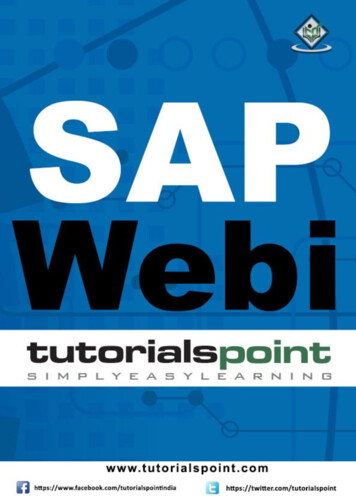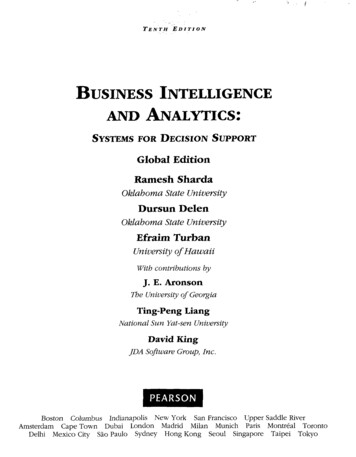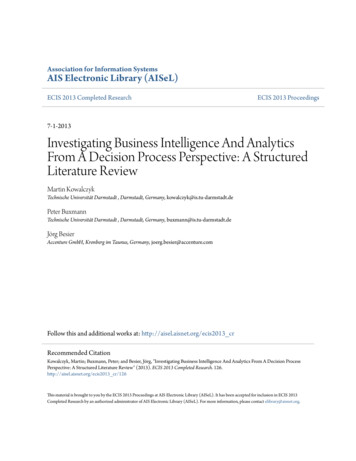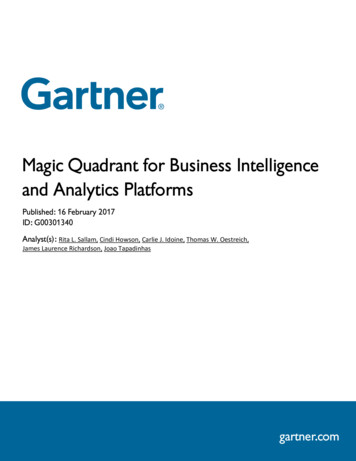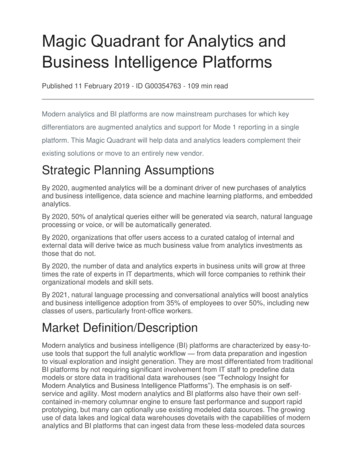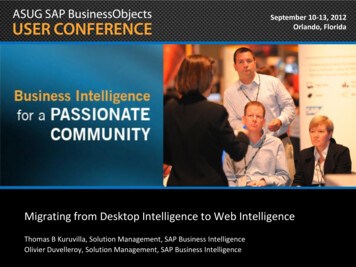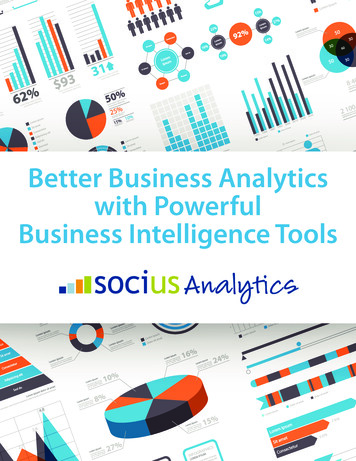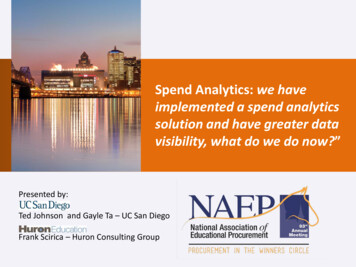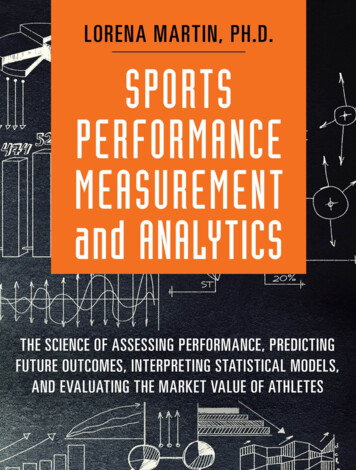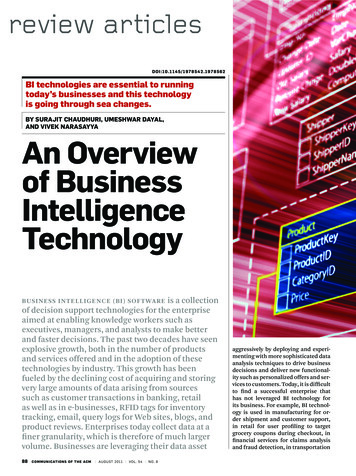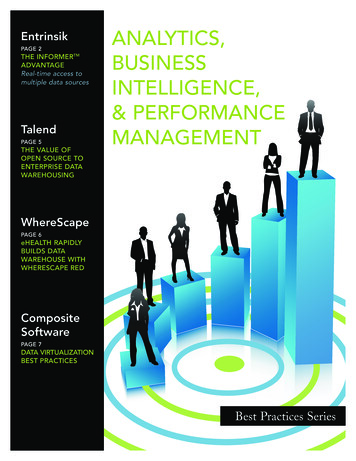
Transcription
EntrinsikPAGE 2THE INFORMERTMADVANTAGEReal-time access tomultiple data sourcesTalendPAGE 5THE VALUE OFOPEN SOURCE TOENTERPRISE DATAWAREHOUSINGANALYTICS,BUSINESSINTELLIGENCE,& PERFORMANCEMANAGEMENTWhereScapePAGE 6eHEALTH RAPIDLYBUILDS DATAWAREHOUSE WITHWHERESCAPE REDCompositeSoftwarePAGE 7DATA VIRTUALIZATIONBEST PRACTICESBest Practices Series
Sponsored Content2THE CHALLENGE:Extending Consolidated Reportingand Analysis to the Front LineTraditionally, full-featuredreporting & analysis solutions havefocused on the needs of executivesthat have a strategic perspective.And because of this limited userpopulation, traditional businessintelligence has focused on historicaldata analysis, such as OLAP, where userstypically evaluate large amounts ofhistorical, trending data. As a result,traditional BI is usually associated withdata warehouses, data marts and othercentralized, large scale, aggregated datastores that can be costly to implementand difficult to manage.However, the rich functionality andinteractivity provided by most BIapplications often prove overwhelming.Most end users need little of thisfunctionality. Instead, they need easyaccess to regularly distributed reports andother analysis capabilities. They needinterfaces and navigation that are logicaland intuitive. Rather than force casualusers to struggle with multiple complexdata structures and queries, reportingshould use easy-to-understand languageand present information clearly. Forreporting and analysis to drive betterperformance, organizations must engagethe majority of users—casual businessusers, managers, and executives—whoneed to securely interact with the datawhen and where they need it.In addition, front-line and businessusers need the flexibility to analyze rapidlychanging data from multiple sources, inmultiple ways, to change how they viewdata, to access data in real time to helpdrive business decisions, and to managereports based on user roles andresponsibilities without the need tounderstand the underlying data schemas. Isa data warehouse or other data store theonly option to support the goal ofconsolidated operational reporting andanalysis across the organization?THE SOLUTION: THE INFORMER ADVANTAGE: REAL-TIME ACCESS TOMULTIPLE DATA SOURCESInformer Web Reporting wasdesigned specifically to extend real-timeself-service reporting and analysiscapabilities to front-line users. With onlya few mouse clicks, organizations canquickly connect multiple sources of datato provide users with a single point ofaccess to dynamic reports via Informer’seasy-to-navigate user interface. Informerpresents information in drag-and-dropform to give users choices in how theywant to assemble, schedule and deliverreports.Users have access to information frommultiple systems, platforms, or locations,eliminating data silo constraints so thatorganizations can optimize the flow anduse of data across the organizationwithout relying on a data warehouse orcentralized data mart. Reportcustomization and ad-hoc querycapabilities mean end users can queryany data source, regardless of where it isstored across relational or MultiValuedata, to build their own reports and getfast answers to their own questions.Web-based analysis enables users to
Sponsored Contentperform on demand analysis in a zerofootprint, Web environment. This selfservice capability means IT can minimizethe resources needed to produce reportswhile providing faster time-to-results forthe end user.THE TECHNOLOGYTechnology has evolved to a pointwhere reporting and analysis needs canbe met without making the biginvestments in time, money, and peoplethat a data warehouse typicallydemands. Informer leverages a metadatamodel that creates consistency amongdata descriptions and structures so userscan effectively access, analyze and reporton data coming from multiple sourceswhile masking users from underlyingdata and system complexities. Informer’sintelligent caching mechanism allowsusers to sort, filter, group, and analyzereport results without bombarding thedatabase server with repetitive requests.Users may also save report results as aData Archive for local viewing later.Informer enables organizations to fullyarm operational users with informationwithout sacrificing databaseperformance.3BOTTOM LINEInformer represents completely newthinking in real-time data access. Instantaccess to multiple data sources. Fastimplementation. Organization-widedeployment. Quick ROI. Highperformance on demand queries.Informer has enabled thousands ofusers worldwide to maximizeperformance and improve bottom linesby tracking, understanding, andmanaging information. By deliveringinstant, up-to-the-second informationaccess, Informer provides organizationswith unprecedented operationalreporting and analysis capabilitiesmaking full use of their data. It’s YourData. We Help You Use It. “Informer enabled our College to createefficiencies within our institution’s businesspractices and was one of the key factors inmy position being rewritten to allow me tospend 50% of my time in new projectdevelopment.”—Wilf Schlitt,Business Support & Student DataSystems, College of New CaledoniaABOUT ENTRINSIK, INC.Since 1984, Entrinsik Inc. has beendeveloping, implementing, and supportingdatabase solutions that enable organizationsto maximize performance and improvebottom lines by tracking, understanding, andmanaging information. Thousands ofcustomers around the world use Entrinsik'sInformer Web Reporting software to nativelyextract data from their production databasesto provide a single point of Web-basedaccess to ad hoc reports for on demandreporting and analysis. Entrinsik's SemtekERP software now drives many of thenation's largest professional and continuingeducation profit centers. To learn more, visitwww.entrinsik.com/offer/dbta or call888-703-0016 today.“Informer has already proven to be aninvaluable reporting solution for several ofour existing customers. The ability to presentinformation in drag-and-drop form givingusers choices in how they want to assemble,analyze, schedule and access reports made abig impact at our recent webinar demo forseveral Public Housing Authorities.”—Greg Clark,Director of Technical Services,Progenixx, Inc.
Sponsored Content4Introducing Best Practices inAnalytics, Business Intelligenceand Performance ManagementWELCOME TO DATABASE TRENDS AND APPLICATIONS (DBTA)MAGAZINE’S FIRST “BEST PRACTICES” SECTIONBeginning with this June 2009 issue, each issue of DBTA will incorporate a newthemed “Best Practices” section designed to deliver relevant case studies,customer references and technology overview/benefits in a clearly defined area ofinformation management. These special sections will be printed and deliveredwithin every issue of DBTA in print, and posted at www.dbta.com for easy PDFdownloading by both you and members of your information management team.The editorial department at DBTA has chosen the area of analytics, businessintelligence and performance management as the first to be covered. According toDBTA research, 42% of our subscribers spend more than five hours per week onBI reporting while 15% of our readers spend more than half of their time everyweek preparing BI reports. Three-quarters of our subscribers report that either ITalone, or IT in collaboration with line-of-business management, evaluate BIsolutions. With all of that work and evaluation going into BI within our readingaudience, this is a highly relevant topic for you and a great place for DBTA toprovide deeper background information on solutions. Of course, the need for BIwill only intensify for most of our readers’ sites as well, since nearly two-thirds(63%) of our readers report that the number of BI users in their organizationswill increase over the next 12 months.Take a few moments to review the articles that follow, visit the websites forfurther information, hang on to this section in print for reference or pass it along. and tell your peers that they can find the same information at www.dbta.comfor downloading as well. Let us know if there are topics you are having difficultywith and where future issues of “Best Practices” can help you in your job.Tom WilsonPresidentUnisphere MediaDivision of Information Today, Inc.
Sponsored Content5The Value of Open Source toEnterprise Data WarehousingBy Yves de Montcheuil, Vice President of Marketing, TalendData Warehousing isn’t a new idea;conceptually it’s been around for 30years. From its initial inception as amethod of storing relevant data fromrelevant systems into a specific applicationused for query reporting analysis, DataWarehousing has evolved into atechnology that consolidates allinformation for the organization into onerepository. An Enterprise Data Warehouse(EDW) consists of multiple subject areas(financing, marketing, sales, etc.) andrepresents areas of interest for groups andfor individuals who examine the dataacross several subject areas.Open source is definitely mature enoughand robust enough to handle EnterpriseData Warehousing (EDW). In just a fewshort years open source has evolved fromsomething “geeky” into an enterprise-readysolution. However, it’s not just that today’sopen source solutions are feature-rich andcan handle user requirements. If you’rebuilding mission-critical systems, you needto look beyond the technology and find avendor who can support and extend thesesolutions.Successful EDW requires a network ofsoftware, hardware, consultants,developers, etc. to support customers andmanage the effort over the time it takesto get a reliable ROI from an EDWproject. The key here is sustainability andthe defining acceptance criterion lies indetermining which companies (andproducts) will be here for the long haul.And these will be commercial opensource vendors (such as Talend) withwell-developed business strategiessurrounding service, support, and valueadded software products.COMMERCIAL OPEN SOURCEVENDORS SHARE A NUMBER OFCHARACTERISTICS They are for-profit organizations thathave dedicated R&D teams at the core ofthe development effort. Although theydepend on the community, they contributethe bulk of the code and control theproduct road map. There are cleardifferences between a commercial opensource vendor and a community-drivenopen source project. The first is backed by acompany, while the second is hosted byvolunteers who contribute their time and,of course, can’t provide any level ofcommitment or service agreement. They are often venture-backed andare in business for the long term.In just a few short years,open source hasevolved into anenterprise-ready solution. They provide the same level ofcommitment as proprietary vendors andthe same level of expertise. They rely onthe same level of partners to help customersimplement their solutions. One of thestrengths of open source software is thepartner network that exists to providecustomers with customized packages thataddress their most fundamentalrequirements. Another factor that makescommercial open source vendors “better”than proprietary vendors is that theirproducts need to be easy to use and mustperform really well.A recent IDC report indicates thatgrowth in U.S. tech spending may declineto 0.9% in 2009. Its prediction forWorldwide IT sales is down to 2.6% froma pre-September forecast of 5.9% growth.These aren’t good numbers. Companiesare under pressure to cut IT budgets.However, as budgets drop, companiesneeding to do more with less are turningto open source solutions, and removingthe cost of license acquisition can reducecosts by up to 90%. In addition, currentcustomers are increasing use, addingcollaboration, customer relationshipmanagement, and supply chainmanagement to the open source solutionsthat already run their servers and databasemanagement systems.The community is also a big draw formany customers, and a significant numberof open source users would rather call onthe community for help addressing issuesthan get support from a dedicated service.In addition to reducing the cost of support(and thereby decreasing their dataintegration budget), the return they getfrom the community is comparable inquality to traditional support from aproprietary vendor. The community alsotends to be more responsive andcommunity tools are no cost to theenterprise. Because the development cycleof open source applications is usually quiteshort, users know that the chances ofgetting a feature request developed andmade available is significantly greater than asimilar request in the proprietary domain.Open source is ready for EDW andoffers far better value for the price.Because open source is designed to bemodular, an enterprise can start with onepiece—say ETL or reporting—and canadd on as needed. For comparable powerand features an open source solution inthis arena will cost 10 to 20 times less thana proprietary product. Whether large orsmall, companies today are being asked todo more with less. With open source, youcan have an EDW without compromise. TALEND The recognized leader in opensource data integration, Talend makesdata integration and data quality solutionsavailable to organizations of all sizes, andfor all integration needs. Talend offersopen, innovative and powerful dataintegration solutions, used primarily forintegration between operational systems,ETL, migration, and data quality.
Sponsored Content6eHealth Rapidly BuildsData Warehouse withWhereScape REDAre you challenged to meet the BIneeds of your business users becauseyou can’t get the data pulledtogether properly? Building andmanaging a data warehouse may be easierthan you think.Leading online health insuranceprovider eHealth moved from a manualreporting environment to a fast, accurateand fully documented reporting andanalytics infrastructure with a fullydocumented data warehouse in just threemonths using WhereScape RED.eHealth’s reporting was causingheadaches. Producing reports tookspecialist IT knowledge, so reports couldonly be produced by the technical team.This was a major bottleneck. Dependingon complexity, reports took anything froma few days to a week to produce.eHealth had a data warehouse that usedhand-written Oracle PL/SQL code to loadand transform the data. How the datawarehouse scripts were crafted, and howthey were maintained, was specialistknowledge. eHealth wanted this specialistknowledge to become commonknowledge, so that a wide variety of teammembers could develop reports.As a public company, eHealth was alsoworking to comply with Sarbanes-Oxleyregulations. Compliance requires fulldocumentation that includes changecontrol, auditing, and the distribution ofreporting functions to ensure dataintegrity. eHealth decided to solve all theseissues by redeveloping its data warehouse.“We needed guidelines, code and structure—not just piecemeal tools,” says BrettEmerton, eHealth’s Manager of BusinessAnalysis. “We chose WhereScape REDbecause it enabled our team to achieve aquick delivery.”“We found other tools either do prettylayouts and no coding, or they do it all andcharge a fortune. We also wanted the wholeteam to understand the data warehouse, andWhereScape works in a clear, simple way.”eHealth began by importing existinglogic and processing into the WhereScapeenvironment. It then converted handwritten procedures into generated codewithin WhereScape. Some of eHealth’stransformations aren’t that easy—they useiterative calculations and customizedfunctions. With WhereScape they got rid ofevery function except one.“It runs an order of magnitude fasterthan the custom code it replaced,” saysBrett Emerton. “When one of our teamsaw the data warehouse rebuild they asked,‘how many years did it take you to dothat?’ It took three months.”“We rebuilt the existing data warehousein far less time than we could have donemanually. While our business rules arecomplex, when broken down visually itlooks very simple. WhereScape shows allthe different steps that make up the code—you can see from the visuals if somethingdoesn’t look right. This visual capabilityhelped us perform debugging, and rebuildsmaller procedures without changing theconstant code,” he says.“With WhereScape it only takes a fewminutes to change schema and tables. Thecurrent schema is designed for runningreports, but WhereScape’s give us theflexibility to run analytics, which is a hugebenefit.”THE BUSINESS PROBLEM Only one person understood the datawarehouse Only one person was able to fill reportrequests Reports took a few days to a week tobuild There was no documentation on datawarehouse processesTHE WHERESCAPE SOLUTION The original hand-coded Oracle PL/SQLdata warehouse was re-developed, usingWhereScape RED guidelines andmethodologyRETURN ON INVESTMENT Users can produce and customize theirown reports Able to run analytics Sarbanes-Oxley compliant Cubes are generated on the fly, with nocode needed Speedy disaster recovery Nightly aggregates of data from 10 webservers Overnight processing slashed tominutes eHEALTH, INC. is the parent company ofeHealthInsurance Services Inc., the leadingonline source of health insurance forindividuals, families and small businesses.eHealth has more than a million insuredcustomers, and is headquartered inMountain View, California. Licensed tomarket and sell health insurance in all 50states and the District of Columbia,eHealthInsurance has developedpartnerships with more than 160 healthinsurance companies. It offers more than7,000 health insurance products onlinethrough the website atwww.ehealthinsurance.com.WHERESCAPE provides a product,WhereScape RED, which enablesorganizations to ensure that the structureof their data always meets the changingneeds of the business. WhereScape REDis the only comprehensive IntegratedDevelopment Environment for datawarehousing that supports the entire datawarehouse management life cycle. Over300 customers worldwide are usingWhereScape RED on a variety of platforms.Users report that projects performed usingWhereScape RED typically come in underbudget, ahead of schedule, with improvedperformance, greater transparency andbuilt on more solid foundations over thesystems they replace. WhereScape hashead offices in Auckland, New Zealand;Portland, Oregon; and Wokingham, UK.
Sponsored Content7Data Virtualization Best Practicesby Composite SoftwareGrow revenue. Cut costs. Increaseproductivity. Reduce risk. Meetingthese mandates requires more data, frommore places, faster than ever before. Thismeans new approaches including datavirtualization.Composite data virtualization enablesenterprises and government agencies tobetter leverage the valuable data scatteredthroughout their organizations.Composite integrates data from multiple,disparate sources—anywhere across theextended enterprise—in a unified,logically virtualized manner forconsumption by nearly any front-endbusiness solution, including BusinessIntelligence, Mashups, Applications,and more.Advancing beyond its roots in highperformance query or enterpriseinformation integration (EII), Compositedata virtualization can be deployed on aproject basis as a complement to otherdata integration approaches such as dataconsolidation / ETL and datasynchronization / EAI /ESB orimplemented across an enterprise asvirtual data abstraction layer, often inservice-oriented architecture (SOA)environments.DUAL DEVELOPMENT ENVIRONMENTSREQUIREDTo best match data virtualization toolswith development teams, Compositesupports two popular techniques, anEclipse IDE and traditional relational datamodeling.ECLIPSE IDEThe Eclipse IDE is a powerful IDEframework with strong support from theopen source community. CompositeSoftware’s Designer supports the Eclipseenvironment for XML/SOA and Javacentric developers. Moreover, CompositeDesigner enables the top-down orcontract-first approach to developmentof standards-based Web services as wellas a range of enhanced graphical editorsB us ines sS olutionsB I, C P M, andR eportingP ortals andMas hupsC us tom andC ompos ite AppsE nterpris eS earchE nterpris eA pproac hE nterpris e Data V irtuali
WhereScape PAGE 6 eHEALTH RAPIDLY BUILDS DATA WAREHOUSE WITH WHERESCAPE RED Composite Software PAGE 7 DATA VIRTUALIZATION BEST PRACTICES . 2 Sponsored Content Traditionally, full-featured reporting & analysis solutions have . offers far better value for the price
